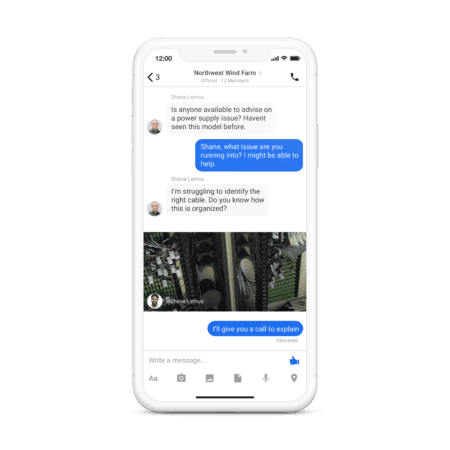Communication is key to a successful working environment — and that is especially true in field service. If your technicians are ill-equipped to communicate with their peers and dispatch, how can they ensure a strong first-time fix rate?
By getting your service team equipped with the right technology and deploying an effective communication strategy, you can avoid the most common field service communication mistakes and drive results for your company.
1. There’s a technology gap
Despite being 80 percent of the workforce, deskless workers have been forgotten and overlooked by technology providers — Emergence Capital reports that only 1 percent of software venture funding is going towards technology serving this segment of the workforce. This has left a gap between desktop workers and deskless workers in terms of technology that allows them to be more effective and efficient at work.
In 2016, a whopping 52 percent of companies were still using manual methods to handle field service. While field service management software is quickly gaining traction, complementary communication software hasn’t been adopted at the same rate.
Instead, companies rely on traditional desktop technology like email and intranet that simply don’t work for mobile field service workers. In the absence of effective communication technology, field teams turn to unsecured consumer apps like WhatsApp and native mobile apps to communicate with their teammates. This leaves the company open to several risks and efficiency blockers:
- Employees can only share knowledge and get help from coworkers whose numbers they know
- IT has no administrative control
- Sensitive communication data isn’t owned and controlled by the company
- When an employee leaves the company, their conversations move with them
- It is impossible to track communication company-wide for analytics
By providing an enterprise-grade mobile communication app built for field service, you can overcome these challenges and then some.
Vivint Smart Home realized the opportunity to improve service team metrics by foregoing email and equipping technicians with an easy-to-use, real-time communication platform. By deploying Zinc Real-Time Communication, field service teams were finally connected to each other and their support teams back at the office. By filling this technology gap, Vivint was able to fix their field service communication mistakes, resulting in a:
- 50% increase in employee engagement
- 37% reduction in time to service
- 23% reduction in returns of installs
- 13% reduction in second visits
2. Company updates don’t reach the field
Not only is effective communication essential in getting work done efficiently, but it is also a significant factor in employee engagement. Field service teams want to be connected to each other as well as the organization they work for. They want to be in-the-know and seen as valuable employees who contribute to the success of the organization.
On a regular basis, leadership should share the company’s goals and vision, be transparent about the company’s performance, and recognize employees when they are doing great work. All of these factors create a healthier work environment that in turn creates more motivated, committed, and productive workers.
A caveat to remember is that these updates will fall on deaf ears if sent through email or intranet. Make sure to leverage the communication technology that your field service team uses each day. Top-down updates could include:
- A video from the CEO or group leader with a company update
- An empowering press article to boost pride and loyalty
- Important corporate information such as HR updates, awards, and company progress
- The latest team metrics to drive competition and increase upsell, customer satisfaction, and NPS
By sharing the big picture with your field teams and ensuring they are just as informed and supported as the employees who work at corporate, you can drive up employee engagement, retention and productivity.
3. Insights don’t make it up the chain
The employees who are out working with customers every day have invaluable insights that senior management needs to hear and leverage to continuously improve the business. If employees have no way to share their learnings, or management is unwilling to listen, you’re missing out on big opportunities for improvement.
All managers or heads of department should see employee communications as part of their job and regularly turn to the employees who know the customer inside out for ways to improve business operations.
You can glean valuable frontline insights from the field teams in a variety of ways.
- Set up dedicated groups for discussing common issues and resolutions
- Send out feedback surveys
- Meet 1:1 with experienced technicians to get honest feedback
- Leverage communication analytics to uncover recurring problems
By listening to the employees who interact with your customers each day and acting on the advice they give, it shows service teams that they are valued by the company. The added plus? You can improve efficiency, business processes, training, service metrics, and more.
Don’t Let These Field Service Communication Mistakes Hurt Your Business
Poor communication can have a significant impact on service efficiency—customers note “slow response rates and poor communication” as one of the biggest causes for disgruntlement. Modern field service companies need technology that optimizes both operations and communications to create a more efficient, empowered and unified workforce.
With the support of the entire organization in their pocket, technicians can meet and exceed both company and customer expectations.

Avoid top field service communication mistakes with Zinc.
Zinc is designed for the deskless worker, with real-time communication in every mode on any device. With Zinc, field teams can:
- Get instant answers from subject-matter experts
- Troubleshoot live with pictures and 1:1 video chats
- Access product information from their mobile devices
- Be alerted to important process changes and safety hazards
- Share success stories and service tips in group chats
- Stay informed on the latest company news


Share this: